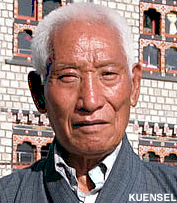|
Bhutanese
Folk and Mask Dance
|
 |
Bhutan's
Culture Traditional Dance |
|
 |
Bhutan Information |
|
|
 |
|
Trashigang:
Keeping the Wang Zhey alive
|
 |
| Ap
Poptey |
| Standing
at the centre of the hall, he watches as a group of more than twenty students
in circle breaks into a song and a dance. Half way through, he notices
some of the students going off tune. As he claps his hand, everybody stops
and stares at him. He then demonstrates a rhythmic movement accompanied
by a loud melodious song.
Teaching
Wang Zhey, a popular folk dance, to the students of Rangjung Higher Secondary
School, Ap Poptey says that it was much easier to train the villagers in
the past compared to students of present days. |
|
 |
 |
| "They
take more time to grasp the movements and even the songs. It may be because
such songs suited people of that era more. They were also exposed to only
such dances but now you have many other options," he said.
Wang
Zhey, danced in groups of varying numbers in both fast and slow rhythm,
was composed by Zhabdrung while the tune and the steps were drafted by
the then Thimphu dzongpon and few lams, according to Ap Poptey, who
at the age of 83 is all set to inculcate the traditional dance in students. |
|
During
the festival a member from each lineage are required to attend the entire
tshechu. Until and unless the festival dismisses for And in the students,
the man from Simodanglo (opposite Namseling) in Thimphu claims that he
sees his own youth, which was spent in performing dances, singing songs,
and playing music.
Ap
Poptey said that besides having a very melodious voice, his polished movements
and elegant expressions made him one of the best performers of his time.
"I performed in many of our country's significant occasions and festivals
and led first group of royal dancers," he said.
He
was a complete artist considering his master over Zhungdra, more than 14
types of Wang Zhey, and playing musical instruments and performing mask
dances. His students included prominent figures like Ap Dopey.
And
all this, he had learned by watching others perform and had not undergone
any kind of formal training.
At
a very young age, he replaced his father in serving at the late King Jigme
Wangchuck's palace. At that time, construction of Kuenga Rabten palace
was underway. Finding it difficult to comply with the strenuous work, he
moved to serve late queen mother Ashi Phuntsho Choden. ( more
information) more
information)
At
that time, he was sent to Paro during a tsechu where he met the third King
who was then a Paro Penlop. He was asked to perform pow (a dance performed
for auspicious beginning) along with three other veterans of the time.
While
he had not taken any formal training, his interest and the little knowledge
he gained by watching Bab Satu, the changap, perform during archery matches
was enough to impress the viewers. He was then commanded to teach the dance
to eight selected villagers at the same time take formal training from
Bab Satu.
"It
was not easy. It was necessary to master the art in one day and it included
perfection in every small details," he told Kuensel.
After
that Ap Poptey traveled to different places looking for promising dancers
with good features and competent voice in the west that later comprised
the royal dancers. "Good looks and voice really mattered at those days,"
he said.
Meanwhile,
Ap Poptey is teaching Wang Zhey and other traditional dances to the students
in schools of Trashigang, with support from the dzongkhag.
Dzongda
Minjur Dorji, who initiated the programme, said that it was important to
make best use of such resourceful person and ensure continuity of the traditional
dances.
"In
many places the originality of the dance is disappearing," he said.
Ap
Poptey agrees. "With time, people are losing interest in such culture,"
he said. "These are part of Bhutanese etiquettes introduced by Zhabdrung
Ngawang Namgyal and is important to preserve it."
| Contributed
by Kesang Dema, KUENSEL, Bhutan's National Newspaper 2007 |
 |
top
| Information on Bhutan |
 |
|




![]() more
information)
more
information)
